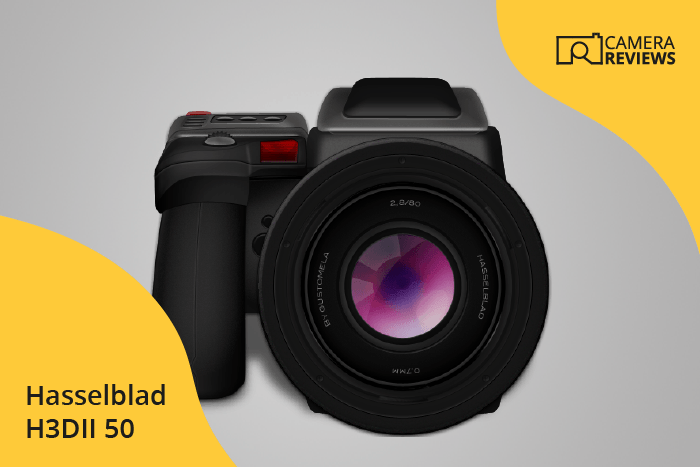Hasselblad H3DII 50 Specs and Scores

The Hasselblad H3DII 50 medium format camera scores a 50 out of 100. Announced on November 26, 2007, and released the same year, it came with a hefty launch price of $20,000. Measuring 153 x 131 x 213mm, this camera weighs 2290g or 5.05lbs.
In today’s market, the H3DII 50’s specifications are quite dated and its size and weight may not be as appealing to modern photographers. However, it remains a classic choice for those interested in medium format cameras.
Hasselblad H3DII 50 Overview and Optics
The optics of the Hasselblad H3DII 50 earns a score of 65 out of 100. This camera features a 50-megapixel CCD sensor, which is medium format in size and provides a 4:3 aspect ratio. The lens mount is specific to the Hasselblad H system, and there is no image stabilization available. The camera’s shooting speed is quite slow at only 1 frame per second, and it uses a Hasselblad processor. The DXOMARK score for the sensor is 78.
In the current market, the Hasselblad H3DII 50’s optics may not be as competitive as some other cameras. The 50-megapixel sensor, while still impressive, is now surpassed by more recent models with higher resolution sensors. Additionally, the lack of image stabilization and slow shooting speed may limit the camera’s versatility for certain types of photography.
Despite these limitations, the Hasselblad H3DII 50 remains a solid choice for photographers who prioritize image quality and the unique characteristics of medium format photography. Its optics may not be the best in today’s market, but it still delivers high-quality images and a distinct shooting experience.
Hasselblad H3DII 50 Video Performance
The Hasselblad H3DII 50 lacks video capabilities. This camera focuses on high-quality still photography and does not offer any video recording functions.
Hasselblad H3DII 50 Features and Benefits
The Hasselblad H3DII 50 features a score of 23/100, which highlights the camera’s limitations in today’s market. With a screen size of 3 inches and a resolution of 230,000 dots, the display is not as sharp as modern cameras. It lacks a touchscreen, flip screen, GPS, WiFi, and Bluetooth capabilities, which are now standard in many contemporary models.
These specifications reveal that the Hasselblad H3DII 50 does not compete well with current cameras, especially in terms of connectivity and user experience. While the camera may have been a strong contender in its time, the rapid advancements in technology have left it trailing behind. It is evident that the Hasselblad H3DII 50 is not the ideal choice for those seeking cutting-edge features and seamless connectivity in today’s photography world.
Hasselblad H3DII 50 Storage and Battery
The Hasselblad H3DII 50 receives a storage and battery score of 16/100. It possesses a single memory card slot, accepting Compact Flash (Type II) cards. In comparison to some cameras in today’s market, this limited storage capacity may not be sufficient for users who require multiple card slots or support for more advanced memory card formats.
Regarding battery life, the H3DII 50 can capture 250 shots with its H3DII-50 battery type. This falls short when compared to modern cameras that offer longer battery life. Additionally, the camera does not support USB charging, limiting the charging options for users.
Taking these specifications into account, the Hasselblad H3DII 50’s storage and battery capabilities may not meet the expectations of users in the current market.
Hasselblad H3DII 50 Alternatives
Do you want to know how the Hasselblad H3DII 50 compares to its competitors? Have a look at the most popular comparisons for this camera below:
- Hasselblad H3DII 50 vs Phase One IQ180
- Canon EOS 70D vs Hasselblad H3DII 50
- Canon EOS Rebel XSi / 450D vs Hasselblad H3DII 50
- Canon PowerShot G1 X Mark III vs Hasselblad H3DII 50
- Fujifilm X-E4 vs Hasselblad H3DII 50
- Fujifilm X-T30 II vs Hasselblad H3DII 50
Hasselblad H3DII 50 FAQ
Does the Hasselblad H3DII 50 Have Built-in Image Stabilization?
The Hasselblad H3DII 50 does not have built-in image stabilization. Users should consider using a tripod or other stabilization methods for sharp images.
Does the Hasselblad H3DII 50 Support 4K Video Recording?
The Hasselblad H3DII 50 does not support 4K video recording or any video functionality, as it is primarily designed for high-quality still photography.
What Size Sensor Does The Hasselblad H3DII 50 Have?
The Hasselblad H3DII 50 features a medium format sensor, which is larger than full-frame sensors, providing higher resolution and better image quality.
Does the Hasselblad H3DII 50 Have a Dual Memory Card Slot?
No, the Hasselblad H3DII 50 has a single memory card slot, which supports CF (CompactFlash) cards.
Does the Hasselblad H3DII 50 Have a Touch Screen?
The Hasselblad H3DII 50 does not have a touch screen. Navigating the menu and adjusting settings is done using buttons and dials on the camera body.
Does the Hasselblad H3DII 50 Have Wi-Fi and Bluetooth?
The Hasselblad H3DII 50 does not have built-in Wi-Fi or Bluetooth connectivity for wireless image transfer or remote camera control.
Does the Hasselblad H3DII 50 Have GPS?
No, the Hasselblad H3DII 50 does not have built-in GPS for geotagging photos with location data.
Is the Hasselblad H3DII 50 Weather Sealed?
The Hasselblad H3DII 50 is not weather-sealed, so it is advisable to protect the camera when shooting in harsh or wet environments.
Does the Hasselblad H3DII 50 Have a Built-in Flash?
No, the Hasselblad H3DII 50 does not have a built-in flash. However, it does have a hot shoe for attaching external flash units if needed.

